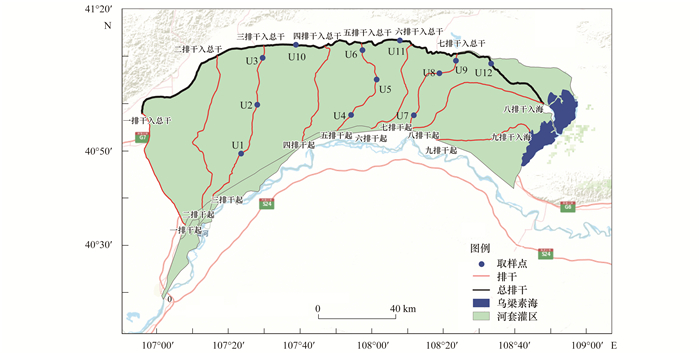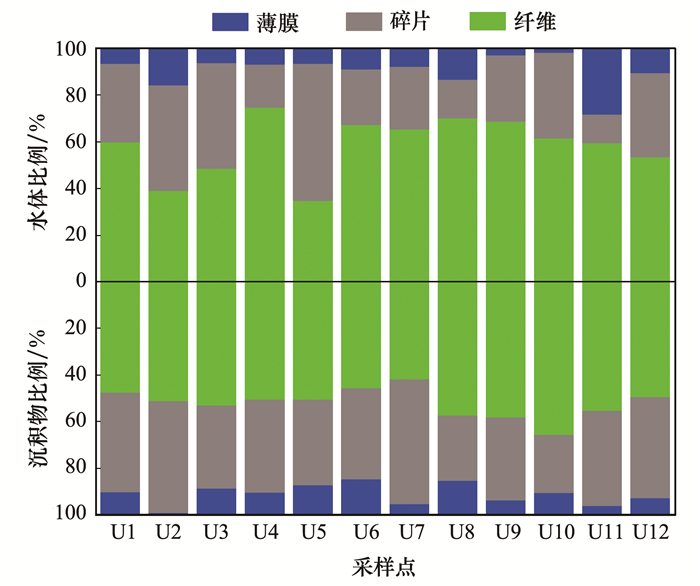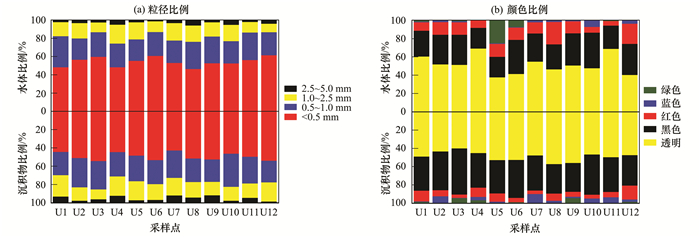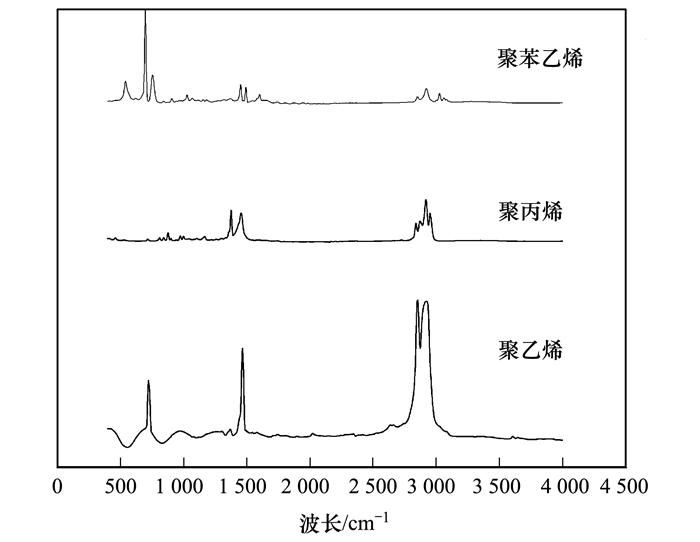2. 内蒙古自治区灌溉排水发展中心, 呼和浩特 010020
2. Inner Mongolia Irrigation and Drainage Development Center, Hohhot 010020, China
微塑料是指大块塑料经紫外线照射、碰撞磨损或工业生产等方式形成的粒径小于5 mm的塑料纤维、颗粒或者薄膜[1].国内外已有研究表明, 微塑料已广泛分布于海洋、陆地、河流、湖泊等自然环境中[2~4], 近来甚至在人类日常食用的食盐、饮用水中都发现了微塑料的踪迹[5, 6].微塑料一旦进入食物链会造成巨大危害:在物理危害方面, 微塑料易被浮游生物、海鸟、鱼类及蚯蚓等动物大量摄食, 对其产生物理损伤, 堵塞消化道, 并在动物体内进行富集[7]; 在化学危害方面, 微塑料自身含有大量有毒化学物质, 同时由于其比表面积大等原因容易吸附土壤、水中的有机污染物和重金属等有毒有害物质[3, 8, 9]; 在生物危害方面, 微塑料吸附的病原菌可能导致摄食生物致病, 甚至有研究表明, 微塑料可以影响物种延续后代, 导致包括血栓、癌症在内的众多疾病[10].目前, 国内外关于微塑料的研究绝大部分集中在海洋, 少量于近海滩涂、大型河流入海口和内陆湖泊[11]等, 研究区域还不够宽泛.根据Tsang等[12]和邵宗泽等[13]的相关研究, 目前微塑料在海水中的最大丰度值已超出每立方米海水100 000个; Zhao等[14]则对我国长江入海口表层水中微塑料的形态和分布密度等研究发现, 长江入海口表层水中微塑料丰度值已达到4 137 n ·m-3, 形态主要为颗粒、纤维和薄膜这3类.然而, 已有研究表明, 海洋中微塑料的70% ~80%都是通过陆地径流引入的, 因微塑料可以在土壤、陆地径流、湖泊及海洋环境中迁移转化, 故关于陆地径流中微塑料的相关研究更受到相关学者的重视[15].但目前微塑料在陆地水环境中赋存特征研究还较匮乏, 且相关研究主要集中在湖泊中微塑料的丰度、形态和生物效应等方面, 而关于陆地径流中微塑料的赋存特征、迁移转化特性及质量估算等方面的研究则鲜有报道.
内蒙古河套灌区作为我国3个特大型灌区之一, 是我国重要的商品粮和油生产基地, 平均每年通过灌区内各级排水沟道排入乌梁素海水量超过5×108 m3, 并在乌梁素海滞蓄后经退水渠排入黄河[16].已有研究表明, 由于河套灌区长期覆膜种植等原因, 农作土壤中微塑料最大平均丰度值已达19 600 n ·kg-1[17], 而土壤中大量微塑料经风力和人为等作用进入河套灌区排水系统, 进而经河套灌区斗沟、支沟、干沟和总排干沟等进入乌梁素海, 并广泛分布于各级排水沟道的水体及底泥沉积物中, 在河套灌区形成了新型污染物.本研究以内蒙古河套灌区大规模覆膜种植为背景, 开展河套灌区排水沟道微塑料分布特征分析, 对黄河流域以农业覆膜种植为主的大中型灌区微塑料的治理也具有重要的指导与借鉴意义.
1 材料与方法 1.1 研究区概况内蒙古河套灌区位于内蒙古自治区西部, 是我国设计灌溉面积最大的灌区, 于2019年9月入选世界灌溉工程遗产名录.受年均蒸发大(约2 200 mm), 年均降水小(约150 mm)等因素影响, 河套灌区灌溉排水系统十分发达, 有各级灌渠991 km, 各级排水沟道791 km[18].其排水系统设七级沟道, 即总排干沟、干沟、分干沟、支沟、斗、农和毛沟等, 现已建成总排干沟1条, 干沟12条, 分干沟45条, 支沟137条, 斗、农和毛沟共计11 275条.总排干沟全长206 km, 是灌区排水、渠道退水和山洪泄水唯一排入黄河的通道, 沿途由一至七排干沟的农田退水和部分城镇的工业废水和生活污水汇入, 最后经乌梁素海入黄河[19].
1.2 样品采集鉴于河套灌区第三、五和七排干水量较大, 分别处于河套灌区的上游、中游及下游, 且水源除河套灌区农田退水外还兼有生活污水和工业废水等, 具有广泛代表性, 故在第三、五和七排干的中游、下游及入总排干处分别设置取样点(U1~U3、U4~U6和U7~U9);另, 在总排干中游、下游及乌梁素海入海口处设置取样点(U10~U12), 详见图 1.采样工作于2019年8月进行, 样品包括水样及底泥沉积物样; 取样过程由特氟龙泵完成, 用硝酸纤维素膜过滤的实验水对泵进行预清洗.抽取水样后, 每个样品通过48 μm不锈钢筛网, 用纯水洗涤筛上的残留物, 于每个取样点距岸边150 cm处, 取水面下20 cm水样20 L, 容器在采样完毕后及时封口, 带回实验室进行检测[20]; 用彼得逊不锈钢采泥器取沉积物样品, 于取水点下采集表层10 cm沉积物样, 所有沉积物样品均装入铝箔封口袋中密封后运回实验室, 将沉积物样品中植物残体、砾石和贝壳等杂质剔除后, 置于避光处自然风干[21].每个取样点设置3组重复取样.

|
图 1 河套灌区取样点示意 Fig. 1 Sampling sites in Hetao irrigation district |
水样经500目不锈钢筛过滤后, 用去离子水将筛上富集的微塑料样品连同其它杂质一并收集于300 mL锥形瓶中, 加入一定体积30% H2 O2溶液, 放置于45℃、150 r ·min-1的振荡培养箱中24 h, 以充分消解有机物和无机杂质.用玻璃纤维过滤器(GF/F; 47 mm; 0.45 μm孔径)进行真空过滤.滤膜放置于干净培养皿中用锡箔纸覆盖, 以避免空气中杂质的污染, 在50℃恒温烘箱中恒温干燥, 在显微镜下观测[22].
沉淀物样品在70℃下干燥24 h至恒重, 并从每个采样点取1 000 g等份试样.将样品移入干净的玻璃烧杯中, 添加30% H2 O2进行消解有机物.将样品再次在70℃下干燥24 h至恒重[23].用氯化钠溶液(1.2 g ·L-1)进行浮选, 将上清液沉降24 h, 用玻璃纤维过滤器(GF/F; 47 mm; 0.7 μm孔径)进行真空过滤.最后, 将滤纸在40℃下干燥24 h后进行提取.每次提取后用浓氯化钠漂洗和洗脱含样品的烧杯, 避免丢失可能附着在烧杯壁上的微塑料颗粒; 最后, 用纯水洗涤残余固体, 在40℃下排水干燥, 在显微镜下观测[24].
1.4 微塑料的鉴别采用立体显微镜(M165FC, 徕卡, 德国)和激光共聚焦显微镜(奥林巴斯, OLS4000)鉴定微塑料的特征(形态、粒径和颜色), 并采用Nano Measuer 1.2软件统计各样点微塑料的丰度值(水体微塑料丰度值的单位是n ·m-3, 沉积物干物质中微塑料丰度值的单位是n ·kg-1)[25, 26].微塑料粒径以最长一边的长度记, 对于不确定的颗粒或粒径小于500 μm的微塑料, 采用傅里叶红外光谱仪(RXI, 美国)对微塑料颗粒进行成分识别.在采样和实验过程中, 避免使用塑料容器, 配置的溶液提前过滤密封待用, 玻璃仪器清洗多次和高温灼烧后方可使用.实验台、室内环境确保洁净, 以减少空气中的塑料成分对实验结果的影响[27].
1.5 总排干微塑料质量估算方法已有研究表明, 受微塑料密度等因素影响, 微塑料在水环境中呈现不同的垂直分布特征, 其中表层水体(0~20 cm)塑料丰度值约为底层水体微塑料丰度值的4倍[28], 即表层20 cm水体中微塑料占水体微塑料总量的80%.故可通过比例流量法估算河套灌区总排干微塑料质量[29].假定总排干中同一断面不同水深处流量恒定, 将取样水深(Hq)与取样点的总水深(Hz)之比记为比例深度(Hb)[式(1)]; 则比例深度(Hb)与流量(Qz)的乘积即为总排干的比例流量(Qb)[式(2)]; 故单位时间内流经总排干表层水体的微塑料总质量(Mb)即为比例流量(Qb)与表层水体单位体积内微塑料的质量(M)之积[式(3)]; 因而1 d(24 h)内流经河套灌区总排干的微塑料总质量(Mz)可表示为表层水体的微塑料总质量(Mb)与比例系数的乘积[式(4)].本研究取样水深Hq为0.2 m; 取样点的总水深、总排干流量从当地水文监测站获取, 其中取样点的总水深Hz为2.6 m、总排干流量Qz为31.72 m3 ·s-1; 比例系数为1.25.

|
(1) |

|
(2) |

|
(3) |

|
(4) |
式中, Hq:取水深度(m); Hz:河流深度(m); Hb:比例深度; Qz:总排干流量(m3 ·s-1); Qb:比例流量(m3 ·s-1); τ:比例系数; Mz:微塑料总质量(g).
因微塑料形态各异, 单个微塑料的质量差异较大, 难以利用微塑料数量与单个质量乘积的方法来估算微塑料的质量, 故本文通过密度体积法估算河套灌区总排干表层水体单位体积内微塑料的质量(M)[30].根据前人相关研究, 取水环境中微塑料的平均密度1.04 g ·cm-3作为总排干表层水体微塑料的密度值[30, 31].单个微塑料的体积则根据微塑料的具体形态特征进行计算, 其主要形态包括碎片、薄膜及纤维; 其中, 碎片和薄膜状微塑料(统称为非纤维)在显微镜垂直观察视觉下呈圆扁平状, 参照已有相关研究, 其体积按球体体积乘以形状因子计算[32] [式(5)]; 纤维状微塑料体积则按圆柱体进行计算[式(6)].本研究非纤维状微塑料直径取该微塑料的粒径区间的平均值, 形状因子取0.1, 纤维状微塑料取实验测得的平均半径(10 μm)[33].故表层水体单位体积内非纤维微状塑料的质量(M1)和纤维微状塑料的质量(M2)及其总质量(M)可用下式表示:

|
(5) |

|
(6) |

|
(7) |
式中, M1:非纤维状微塑料的质量(g); M2:纤维状微塑料的质量(g); R:非纤维状微塑料半径(cm); α:形状因子; L:纤维状微塑料的测量长度(cm); M:表层水体单位体积内微塑料的质量(g).
2 结果与讨论 2.1 各排干微塑料的丰度与分布差异河套灌区各排水干沟水体和沉积物中均检测出微塑料存在(图 2), 水体平均丰度值为(14 310±3 571) n ·m-3, 最小为2 880 n ·m-3(U10), 最大为11 200 n ·m-3(U12).与国内外其他陆地径流中微塑料赋存丰度值相比, 河套灌区排干中的微塑料丰度值处于中上水平(表 1).另由图 2(a)可知, 对于同一条排水干沟, 均呈现出排水沟道中下游微塑料的丰度显著高于上游的趋势(P < 0.05), 其中, 三、五和七排干和总排干中、下游微塑料丰度分别较上游增长7.24%和21.72%、40.28%和45.37%、119.20%和50.33%、63.89%和288.89%.产生这一现象的原因一是微塑料作为水体中非可溶性物质, 分子结构稳定, 不易进一步被分解和吸收[34], 在排干中的水动力作用下, 从上游到下游不断在水体中持续累积, 导致排干下游水体中微塑料丰度越来越大; 二是从上游到下游随着排干的不断延长, 排干周围的各种塑料垃圾、生活垃圾、农田碎料残膜等也以风、水流等形式大量地汇入到排干或总排干中, 产生较大的面源污染[20], 以集聚现象最明显且距离最长的总排干为例, 下游微塑料丰度(U12)是上游(U10)的2.88倍.从图 2(a)可以发现, 七排干中游(U8)微塑料丰度值[(6 620±1 557)n ·m-3]高于下游丰度值[(4 540±1 230)n ·m-3], 经现场勘察发现七排干中游附近有较多的工厂存在, 村庄和城镇数量也较多, 人口密度较大, 产生更多的工业废水和生活污染物, 致使附近河流内的微塑料丰度值显著增加.

|
图 2 河套灌区各排干中微塑料的丰度值 Fig. 2 Abundance of microplastics in drainage of Hetao irrigation district |
|
|
表 1 国内外河流微塑料的丰度 Table 1 Abundance, main types, and sizes of microplastics in rivers of China and abroad |
河套灌区各排水干沟沉积物中微塑料的平均丰度值为(229±42)n ·kg-1, 最小为100 n ·kg-1(U10), 最大为292 n ·kg-1(U3), 与其他地表径流沉积物微塑料丰度值相比基本处于中等水平(表 1).总体上, 三排干沉积物中的微塑料丰度值高于五排干、七排干和总排干, 这是由于三排干流速缓慢, 排干中水深较浅, 有利于微塑料的沉积; 而七排干中游U8点沉积物丰度值亦较高[(289±52)n ·kg-1], 这则与U8点水体中微塑料的高丰度值密不可分.另由图 2(b)可知, 总排干沉积物中微塑料的丰度并不比各排干中大, 甚至总排上游(U10)沉积物中的微塑料是所有采样点中最小的[(100±22)n ·kg-1], 原因是随着1~7排干中的水量汇入总排干, 总排干中水量增加, 流速变快, 导致水力条件不利于微塑料的沉淀, 只有少量的微塑料能够沉入到沉积物中[35, 36].综上所述, 陆地径流沉积物中的微塑料丰度值不仅与水体中微塑料的丰度值密切相关, 更受水体流量、流速等外界条件的影响, 较高的水体微塑料丰度、较低的河流流速所产生的耦合效应是导致沉积物中微塑料丰度值增加的重要原因.同时, 比较图 2可以发现, 与同一排干不同取样点水体间微塑料丰度差值较大相比, 同一排干上、中、下游沉积物中微塑料的丰度差值则相对偏小, 分析可知, 水体中微塑料的分布可能受直接外源污染、气象条件、水环境特征和人类活动多种因素的影响[37], 波动值较大; 而沉积物中微塑料与水体中处于悬浮状态的微塑料相比, 因其受到固体沉积物的束缚作用, 迁移转化速率较慢, 丰度值则更趋于稳定.
2.2 各排干微塑料的外形特征河套灌区排水干沟内的微塑料形态不同, 大小不一, 颜色各异.通过激光共聚焦显微镜观察表明, 排干中微塑料形态主要分为纤维、碎片和薄膜这3种形态(图 3).其中, 纤维状微塑料在水体和沉积物中均占比最大, 分别达到34.98% ~70.39%和42.24% ~58.56%(图 4), 其次是碎片状和薄膜状.分析认为纤维状微塑料不仅来源于人类日常生产、生活中的化妆品、洗面奶等初级微塑料, 更来源于大型塑料甚至碎片状、薄膜状微塑料的进一步风化、分解所产生的次级微塑料[45, 46].而王志超等[16]通过对河套灌区农作土壤0~30 cm土层范围内微塑料形态特征观察发现, 薄膜状微塑料在农作土壤表层所占比重最大, 为38.57%, 与本研究中微塑料在河套灌区排干的类型分布规律差异较大, 究其原因, 主要是因为农作土壤中的微塑料主要来源于大块残留农膜的降解和风化, 导致农作土壤中微塑料主要以薄膜状为主, 而随着时间的推移, 薄膜状微塑料逐渐进一步降解为纤维类, 向土壤深层迁移并随地下径流及地表径流等, 经各级毛、农、斗和支沟逐步汇入河套灌区排干和总排干; 加之各排干的水流冲刷及河套灌区的强烈光照和风等自然因素对微塑料分解的促进作用, 导致水体中主要以纤维状微塑料为主[47].

|
(a)碎片; (b)薄膜; (c)纤维 图 3 河套灌区各排干中微塑料的不同形态 Fig. 3 Different shape of microplastics in drainage of Hetao irrigation district |

|
图 4 河套灌区各排干中微塑料形状比例 Fig. 4 Ratio of microplastic shape in drainage of Hetao irrigation district |
各采样点微塑料粒径分布如图 5(a)所示, 从中可知河套灌区排干内收集的微塑料以 < 0.5 mm粒径最多, 分别占据水体和沉积物微塑料的46.43% ~61.51%和43.27% ~54.79%, 其次是0.5~1.0 mm粒径微塑料, 总体而言0~1 mm微塑料占据排干水体(74.26% ~86.94%)和沉积物(70.21% ~85.61%)微塑料的绝大多数.这与已有研究表明的微塑料的含量与其粒径呈负相关, 即粒径越小、含量越高[42]的结论相一致, 分析认为, 排干中大粒径微塑料在长期浸泡和水力腐蚀以及机械摩擦的作用下, 会破碎、剥离成小块, 进而转化成更小粒径的微塑料[48].河套灌区排干内的微塑料颜色丰富, 分别为透明、黑色、红色、蓝色和绿色, 如图 5(b)所示.在水体和沉积物中均以透明色微塑料为主, 分别占据微塑料的46.43% ~61.51%和40.41% ~57.44%, 其次是黑色.已有研究表明, 河套灌区农作土壤0~30 cm土层范围内微塑料主要以黑色和透明的为主, 在0~10 cm土层范围内, 黑色微塑料居多, 占30.25%, 在>10~20和>20~30 cm土层范围内则以透明微塑料居多, 分别占该层微塑料总数的30.15%和29.23%[16].调查可知, 河套灌区主要覆盖农膜的颜色以黑色和透明色为主, 这是造成农作土壤微塑料以黑色和透明为主的主要原因, 而河套灌区排水沟道水体和底泥中微塑料亦以上述两种颜色为主, 说明尽管排干中微塑料的来源相对农作土壤更加丰富, 包括生活及工厂等产生的废弃物, 但其主要来源还是大规模覆膜种植导致的农膜残留.且随微塑料在整个河套灌区的迁移转化路径, 黑色微塑料从土壤表层到土壤深层, 再到排水干沟, 其占比一直在减小, 分析认为这可能是因为黑色微塑料更易吸收太阳辐射, 导致其风化及降解速率快于其他颜色微塑料, 因而微塑料的迁移转化受其自身颜色因素影响较大.

|
图 5 河套灌区各排干中微塑料粒径和颜色比例 Fig. 5 Ratio of the microplastic size and color in drainage of Hetao irrigation district |
通过傅里叶红外光谱(FTIR)来鉴定微塑料的主要成分(图 6).在所有样品中随机选出100个微塑料进行检测, 结果显示其中PE(聚乙烯)为主要类型(43%), 其次是PS(聚苯乙烯, 34%)和PP(聚丙烯, 16%).PE和PP具有良好的耐热、耐稳定等机械性能, 被广泛用于塑料农膜, 方便袋, 外包装等, PS则为热塑性树脂, 由于其成本低和方便处理而被广泛应用于日常装饰和化妆品等[49].另外, 在沉积物样品中亦检测到PE和PP的存在, 对于低密度的微塑料能通过水体进入沉积物的原因, 分析认为既可能是温度, 波浪, 盐度或风等自然条件加剧了微塑料颗粒的沉降, 也可能是生物力或其他外力改变了微塑料的比表面积, 导致其沉降于沉积物中[50].而王志超等对河套灌区的退水湖泊——乌梁素海中微塑料的赋存特征研究表明, 乌梁素海水体中微塑料也主要以聚乙烯(63.7%)为主[20], 说明聚乙烯经河套灌区各排水干沟进入乌梁素海后, 经滞蓄作用, 在乌梁素海进行了累积, 导致其含量升高, 但微塑料从农田土壤到退水湖泊的迁移机制仍不明, 因而关于微塑料从河套灌区农田到各排水干沟, 并最终汇入乌梁素海的迁移转化研究有待进一步开展.

|
图 6 微塑料样品FTIR图像 Fig. 6 FTIR image of microplastic sample |
由图 5(a)将微塑料按粒径分为 < 0.5、0.5~1.0、1.0~2.5和2.5~5.0 mm这4类进行质量估算.由表 2可知, 内蒙古河套灌区总排水干沟水体中每天输送的微塑料质量约为116.06 kg, 即每年42.36 t.从粒径而言, < 0.5 mm微塑料质量最小, 占微塑料总质量的0.35%, 2.5~5.0 mm微塑料质量最大, 占微塑料总质量的76.03%, 故微塑料的质量与其粒径分布呈显著的正相关关系, 粒径越大微塑料质量越大; 从形态而言, 碎片状、薄膜状、纤维状微塑料的质量依次减小, 分别占微塑料总质量的71.27%、28.55%和0.17%, 而纤维状微塑料的平均数量却是最多的, 因而微塑料的质量受其数量影响较小, 主要还是受其粒径影响较大.故内蒙古河套灌区赋存的微塑料随地表和地下径流经各级排水干沟汇入总排水干沟, 每年通过总排水干沟约向乌梁素海排放42.36 t微塑料, 并在乌梁素海积蓄后产生严重的微塑料污染效应.本研究成果也与王志超等[20]对乌梁素海中微塑料的空间分布特征研究相一致, 在该研究中, 乌梁素海表层水体中微塑料丰度最大值为(10 120±4 090)n ·m-3, 位置即为总排水干沟入乌梁素海的湖口附近, 并呈现微塑料丰度由总排干入湖口向乌梁素海南部湖区逐渐递减的态势.
|
|
表 2 河套灌区总排干微塑料日输送质量估算数1) Table 2 Estimated the daily discharge quality of microplastics |
而目前国内外对地表径流微塑料的质量估算研究较少, 尚无法综合评判河套灌区总排干输送微塑料的污染程度, 但与韩国第一长河流洛东江相比[30], 内蒙古河套灌区总排水干沟的微塑料输送情况基本与其处于同等水平; 洛东江全长523 km, 年输送微塑料85.65 t, 其长度约为河套灌区总排干的2倍, 年微塑料输送量也基本为2倍关系.另外, 本研究采用比例流量法对河套灌区总排干微塑料输送质量进行估算, 而由于地表径流的微塑料输送受其长度、流量、流态及微塑料的密度、形态和粒径等多因素耦合影响, 故对地表径流进行微塑料输送能力的准确计算难度较大, 故有待进一步综合考虑各影响因素对微塑料的输送量进行研究, 以提高微塑料质量计算的准确性.
3 结论本研究结果表明:内蒙古河套灌区排水干沟和总排水干沟水体与沉积物均有微塑料赋存, 从三排干上游到总排干下游, 丰度分布有明显空间差异.水体中微塑料丰度范围为2 880~11 200 n ·m-3, 沉积物中微塑料丰度范围为100~292 n ·kg-1.最常见的微塑性形状是纤维状, 分别占据水体微塑料的34.98% ~70.39%和沉积物微塑料的42.24% ~58.56%;微塑料颜色以透明为主, 在水体和沉积物微塑料中分别占据46.43% ~61.51%和40.41% ~57.44%;微塑料粒径以 < 1 mm居多, 其占比与粒径呈负相关, 聚乙烯(43%)则是最常见的聚合物类型, 这与该地区农田退水带来的残留农膜及其周围高强度的人类活动密不可分.本研究通过比例流量法估算河套灌区总排水干沟每年向乌梁素海输送微塑料质量可达42.36 t, 对乌梁素海的生态安全产生一定影响.
| [1] | Carbery M, O'Connor W, Palanisami T. Trophic transfer of microplastics and mixed contaminants in the marine food web and implications for human health[J]. Environment International, 2018, 115: 400-409. DOI:10.1016/j.envint.2018.03.007 |
| [2] | Siegfried M, Koelmans A A, Besseling E, et al. Export of microplastics from land to sea. A modelling approach[J]. Water Research, 2017, 127: 249-257. DOI:10.1016/j.watres.2017.10.011 |
| [3] |
李文华, 简敏菲, 刘淑丽, 等. 鄱阳湖湖口-长江段沉积物中微塑料与重金属污染物的赋存关系[J]. 环境科学, 2020, 41(1): 242-252. Li W H, Jian M F, Liu S L, et al. Occurrence Relationship between microplastics and heavy metals pollutants in the estuarine sediments of Poyang Lake and the Yangtze River[J]. Environmental Science, 2020, 41(1): 242-252. |
| [4] | Rillig M C, Ziersch L, Hempel S. Microplastic transport in soil by earthworms[J]. Scientific Reports, 2017, 7(1): 1362. DOI:10.1038/s41598-017-01594-7 |
| [5] | Yang D Q, Shi H H, Li L, et al. Microplastic pollution in table salts from China[J]. Environmental Science & Technology, 2015, 49(22): 13622-13627. |
| [6] | Panno S V, Kelly W R, Scott J, et al. Microplastic contamination in karst groundwater systems[J]. Ground Water, 2019, 57(2): 189-196. |
| [7] | Sharma S, Chatterjee S. Microplastic pollution, a threat to marine ecosystem and human health:a short review[J]. Environmental Science and Pollution Research, 2017, 24(27): 21530-21547. DOI:10.1007/s11356-017-9910-8 |
| [8] | Rillig M C, Ingraffia R, De Souza Machado A A. Microplastic incorporation into soil in Agroecosystems[J]. Frontiers in Plant Science, 2017, 8: 1805. DOI:10.3389/fpls.2017.01805 |
| [9] | Seidensticker S, Zarfl C, Cirpka O A, et al. Shift in mass transfer of wastewater contaminants from microplastics in the presence of dissolved substances[J]. Environmental Science & Technology, 2017, 51(21): 12254-12263. |
| [10] | Prata J C. Airborne microplastics:consequences to human health?[J]. Environmental Pollution, 2018, 234: 115-126. DOI:10.1016/j.envpol.2017.11.043 |
| [11] | Anderson P J, Warrack S, Langen V, et al. Microplastic contamination in Lake Winnipeg, Canada[J]. Environmental Pollution, 2017, 225: 223-231. DOI:10.1016/j.envpol.2017.02.072 |
| [12] | Tsang Y Y, Mak C W, Liebich C, et al. Microplastic pollution in the marine waters and sediments of Hong Kong[J]. Marine Pollution Bulletin, 2017, 115(1-2): 20-28. DOI:10.1016/j.marpolbul.2016.11.003 |
| [13] |
邵宗泽, 董纯明, 郭文斌, 等. 海洋微塑料污染与塑料降解微生物研究进展[J]. 应用海洋学学报, 2019, 38(4): 490-501. Shao Z Z, Dong C M, Guo W B, et al. Marine microplastic distribution and plastic degrading microorganisms:a review[J]. Journal of Applied Oceanography, 2019, 38(4): 490-501. |
| [14] | Zhao S Y, Wang T, Zhu L X, et al. Analysis of suspended microplastics in the Changjiang Estuary:Implications for riverine plastic load to the ocean[J]. Water Research, 2019, 161: 560-569. DOI:10.1016/j.watres.2019.06.019 |
| [15] |
刘治君, 杨凌肖, 王琼, 等. 微塑料在陆地水环境中的迁移转化与环境效应[J]. 环境科学与技术, 2018, 41(4): 59-65, 90. Liu Z Q, Yang L X, Wang Q, et al. Migration and transformation of microplastics in terrestrial waters and effects on eco-environment[J]. Environmental Science & Technology, 2018, 41(4): 59-65, 90. |
| [16] |
王志超, 孟青, 于玲红, 等. 内蒙古河套灌区农田土壤中微塑料的赋存特征[J]. 农业工程学报, 2020, 36(3): 204-209. Wang Z C, Meng Q, Yu L H, et al. Occurrence characteristics of microplastics in farmland soil of Hetao Irrigation District, Inner Mongolia[J]. Transactions of the Chinese Society of Agricultural Engineering, 2020, 36(3): 204-209. |
| [17] |
刘亚菲.滇池湖滨农田土壤中微塑料数量及分布研究[D].昆明: 云南大学, 2018. Liu X F. Quantity and distribution of microplastics in farmland soil of lake shore in Dianchi Lake[D]. Kunming: Yunnan University, 2018. http://cdmd.cnki.com.cn/Article/CDMD-10673-1018248753.htm |
| [18] |
侯凯旋, 岳卫峰, 孟恺恺, 等. 内蒙古河套灌区秋浇对区域尺度地下水水化学影响分析——以义长灌域为例[J]. 灌溉排水学报, 2019, 38(6): 85-91, 112. Hou K X, Yue W F, Meng K K, et al. Autumn irrigation alerted the geochemistry of groundwater in Hetao irrigation district:take Yichang irrigation district as an example[J]. Journal of Irrigation and Drainage, 2019, 38(6): 85-91, 112. |
| [19] |
田志强, 霍轶珍, 韩翠莲, 等. 河套灌区总排干沟氮污染负荷分割与估算[J]. 内蒙古农业大学学报(自然科学版), 2019, 40(3): 75-79. Tian Z Q, Huo Y Z, Han C L, et al. Division and estimation of nitrogen pollution load in the general main drain of Hetao Irrigation area[J]. Journal of Inner Mongolia Agricultural University (Natural Science Edition), 2019, 40(3): 75-79. |
| [20] | Wang Z C, Qin Y M, Li W P, et al. Microplastic contamination in freshwater:first observation in Lake Ulansuhai, Yellow River Basin, China[J]. Environmental Chemistry Letters, 2019, 17(4): 1821-1830. DOI:10.1007/s10311-019-00888-8 |
| [21] | Nel H A, Dalu T, Wasserman R J. Sinks and sources:assessing microplastic abundance in river sediment and deposit feeders in an Austral temperate urban river system[J]. Science of the Total Environment, 2018, 612: 950-956. DOI:10.1016/j.scitotenv.2017.08.298 |
| [22] | van der Noam H, Ariel A, Angel D L. Exceptionally high abundances of microplastics in the oligotrophic Israeli Mediterranean coastal waters[J]. Marine Pollution Bulletin, 2017, 116(1-2): 151-155. DOI:10.1016/j.marpolbul.2016.12.052 |
| [23] | Turner S, Horton A A, Rose N L, et al. A temporal sediment record of microplastics in an urban lake, London, UK[J]. Journal of Paleolimnology, 2019, 61(4): 449-462. DOI:10.1007/s10933-019-00071-7 |
| [24] | Di M X, Wang J. Microplastics in surface waters and sediments of the Three Gorges Reservoir, China[J]. Science of the Total Environment, 2018, 616-617: 1620-1627. DOI:10.1016/j.scitotenv.2017.10.150 |
| [25] |
刘淑丽, 简敏菲, 周隆胤, 等. 鄱阳湖湿地候鸟栖息地微塑料污染特征[J]. 环境科学, 2019, 40(6): 2639-2646. Liu S L, Jian M F, Zhou L Y, et al. Pollution characteristics of microplastics in migratory bird habitats located within Poyang Lake wetlands[J]. Environmental Science, 2019, 40(6): 2639-2646. |
| [26] |
刘启明, 梁海涛, 锡桂莉, 等. 厦门湾海滩微塑料污染特征[J]. 环境科学, 2019, 40(3): 1217-1221. Liu Q M, Liang H T, Xi G L, et al. Microplastic pollution of the beaches in Xiamen Bay, China[J]. Environmental Science, 2019, 40(3): 1217-1221. |
| [27] | Lin L, Zuo L Z, Peng J P, et al. Occurrence and distribution of microplastics in an urban river:A case study in the Pearl River along Guangzhou City, China[J]. Science of the Total Environment, 2018, 644: 375-381. DOI:10.1016/j.scitotenv.2018.06.327 |
| [28] | Song Y K, Hong S H, Eo S, et al. Horizontal and vertical distribution of microplastics in Korean coastal waters[J]. Environmental Science & Technology, 2018, 52(21): 12188-12197. |
| [29] | Miller R Z, Watts A J R, Winslow B O, et al. Mountains to the sea:River study of plastic and non-plastic microfiber pollution in the northeast USA[J]. Marine Pollution Bulletin, 2017, 124(1): 245-251. |
| [30] | Eo S, Hong S H, Song Y K, et al. Spatiotemporal distribution and annual load of microplastics in the Nakdong River, South Korea[J]. Water Research, 2019, 160: 228-237. DOI:10.1016/j.watres.2019.05.053 |
| [31] | Besseling E, Quik J T K, Sun M Z, et al. Fate of Nano-and microplastic in freshwater systems:a modeling study[J]. Environmental Pollution, 2017, 220: 540-548. DOI:10.1016/j.envpol.2016.10.001 |
| [32] | Connors K A, Dyer S D, Belanger S E. Advancing the quality of environmental microplastic research[J]. Environmental Toxicology and Chemistry, 2017, 36(7): 1697-1703. DOI:10.1002/etc.3829 |
| [33] | Kooi M, Besseling E, Kroeze C, et al. modeling the fate and transport of plastic debris in freshwaters: review and guidance[A]. In: Wagner M, Lambert S (Eds.). Freshwater Microplastics: Emerging Environmental Contaminants? Cham: Springer, 2018. 125-152. |
| [34] | Silva A B, Bastos A S, Justino C I L, et al. Microplastics in the environment:challenges in analytical chemistry-a review[J]. Analytica Chimica Acta, 2018, 1017: 1-19. DOI:10.1016/j.aca.2018.02.043 |
| [35] | Wang T, Zou X Q, Li B J, et al. Preliminary study of the source apportionment and diversity of microplastics:taking floating microplastics in the South China Sea as an example[J]. Environmental Pollution, 2019, 245: 965-974. DOI:10.1016/j.envpol.2018.10.110 |
| [36] | Mataji A, Taleshi M S, Balimoghaddas E. Distribution and characterization of microplastics in surface waters and the southern Caspian sea coasts sediments[J]. Archives of Environmental Contamination and Toxicology, 2020, 78(1): 86-93. |
| [37] | Frère L, Paul-Pont I, Rinnert E, et al. Influence of environmental and anthropogenic factors on the composition, concentration and spatial distribution of microplastics:a case study of the Bay of Brest (Brittany, France)[J]. Environmental Pollution, 2017, 225: 211-222. DOI:10.1016/j.envpol.2017.03.023 |
| [38] | Ding L, Mao R F, Guo X T, et al. Microplastics in surface waters and sediments of the Wei River, in the northwest of China[J]. Science of the Total Environment, 2019, 667: 427-434. DOI:10.1016/j.scitotenv.2019.02.332 |
| [39] | Zhang J X, Zhang C L, Deng Y X, et al. Microplastics in the surface water of small-scale estuaries in Shanghai[J]. Marine Pollution Bulletin, 2019, 149: 110569. DOI:10.1016/j.marpolbul.2019.110569 |
| [40] | Xiong C X, Wu C X, Elser J J, et al. Occurrence and fate of microplastic debris in middle and lower reaches of the Yangtze River-From inland to the sea[J]. Science of the Total Environment, 2019, 659: 66-73. DOI:10.1016/j.scitotenv.2018.12.313 |
| [41] |
徐沛, 彭谷雨, 朱礼鑫, 等. 长江口微塑料时空分布及风险评价[J]. 中国环境科学, 2019, 39(5): 2071-2077. Xu P, Peng G Y, Zhu L X, et al. Spatial-temporal distribution and pollution load of microplastics in the Changjiang Estuary[J]. China Environmental Science, 2019, 39(5): 2071-2077. |
| [42] | Wen X F, Du C Y, Xu P, et al. Microplastic pollution in surface sediments of urban water areas in Changsha, China:Abundance, composition, surface textures[J]. Marine Pollution Bulletin, 2018, 136: 414-423. DOI:10.1016/j.marpolbul.2018.09.043 |
| [43] | Leslie H A, Brandsma S H, Van Velzen M J M, et al. Microplastics en route:field measurements in the Dutch river delta and Amsterdam canals, wastewater treatment plants, North Sea sediments and biota[J]. Environment International, 2017, 101: 133-142. DOI:10.1016/j.envint.2017.01.018 |
| [44] | Blair R M, Waldron S, Phoenix V R, et al. Microscopy and elemental analysis characterisation of microplastics in sediment of a freshwater urban river in Scotland, UK[J]. Environmental Science and Pollution Research, 2019, 26(12): 12491-12504. DOI:10.1007/s11356-019-04678-1 |
| [45] | Guerranti C, Martellini T, Perra G, et al. Microplastics in cosmetics:environmental issues and needs for global bans[J]. Environmental Toxicology and Pharmacology, 2019, 68: 75-79. DOI:10.1016/j.etap.2019.03.007 |
| [46] | Hernandez E, Nowack B, Mitrano D M. Polyester textiles as a source of microplastics from households:A mechanistic study to understand microfiber release during washing[J]. Environmental Science & Technology, 2017, 51(12): 7036-7046. |
| [47] | Cesa F S, Turra A, Baruque-Ramos J. Synthetic fibers as microplastics in the marine environment:a review from textile perspective with a focus on domestic washings[J]. Science of the Total Environment, 2017, 598: 1116-1129. DOI:10.1016/j.scitotenv.2017.04.172 |
| [48] | Zhang W W, Zhang S F, Wang J Y, et al. Microplastic pollution in the surface waters of the Bohai Sea, China[J]. Environmental Pollution, 2017, 231: 541-548. DOI:10.1016/j.envpol.2017.08.058 |
| [49] |
罗雅丹, 林千惠, 贾芳丽, 等. 青岛4个海水浴场微塑料的分布特征[J]. 环境科学, 2019, 40(6): 2631-2638. Luo Y D, Lin Q H, Jia F L, et al. Distribution characteristics of microplastics in Qingdao coastal beaches[J]. Environmental Science, 2019, 40(6): 2631-2638. |
| [50] | Sathish N, Jeyasanta K I, Patterson J. Abundance, characteristics and surface degradation features of microplastics in beach sediments of five coastal areas in Tamil Nadu, India[J]. Marine Pollution Bulletin, 2019, 142: 112-118. DOI:10.1016/j.marpolbul.2019.03.037 |
 2020, Vol. 41
2020, Vol. 41


